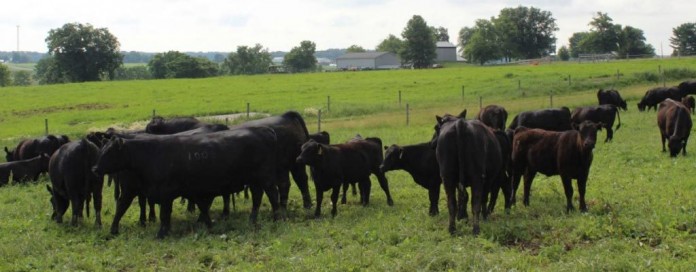For the region that this paper covers, the spring we are having, and each producer’s situation, this is a difficult question. However, for most of us, the answer is “yes!” The recent warm weather has allowed the pasture and hay fields to really start growing at a fast clip. During the past week, many have been discussing if they had started to graze their livestock yet.
When to start?
There are several different thoughts on when to start grazing and I admittedly take a very aggressive approach to start grazing in the spring.
I will even confess that it probably started thirty years ago when I was running out of hay. I start grazing as soon as I can.
I use two different approaches to early grazing.
The first one is to use a “stockpiled” hay field (I made two cuttings of hay last summer, then let the field grow from August to March) and put my spring calving cows in the field March 5, just prior to the beginning of calving season.
No more hay
The last day I fed them hay was March 4. They spent three weeks on the stockpiled grass, most had their calves on a “high and dry” field with little to no mud and the cows actually improved their body condition.
On March 26, I grouped the spring calving cows with the fall calving cows and started a fast rotation around my pastures. I also included several hay fields in the rotation to extend the early grazing.
Grazing pastures
By this weekend, I will cease grazing the hayfields and only graze my permanent pastures.
Around my area, the pastures are really growing well now and I now have enough forages growing in my pastures that I do not need the hayfields to graze.
In addition, if you graze hay fields too long, the yields will be greatly reduced for first cutting. However, if you can remove livestock prior to stem elongation, yields will typically not be reduced too much. There are always exceptions.
Hay maturity
Probably ten years ago, I moved cattle off the hayfields around April 24 and we had very little rain for the next month and yields suffered. However, most years, this works. In addition, it sets the growth back a little and the hay is less mature by the time I get to mowing it in early June.
Another advantage to early grazing is that it sets the grasses back a little and the emerging clovers have less competition as they get established.
There are a couple cautions.
Make magnesium available
First, the early forages will be low in magnesium, since most of the growth is grass, so make sure you have mineral with adequate magnesium available.
Next, if you use hay fields and they are wet, be cautious of potential “pugging” or damaging the fields from hoof action from your livestock.
I have heard over the years that some like to wait until the grass has “strength” because the early growth doesn’t have any nutrients.
High moisture content
There is actually some truth in that as most of the early growth has a high moisture content. However, the quality of the initial growth will probably be the highest of the year.
Two weeks ago, I started feeling guilty as I thought my cows were hungry because the grass was a little short, but when I took them up some square bales of hay, they knocked it around a little, and then went towards the gate. They were not hungry; they just wanted moved to a new field!
Spring flush
Another option some have done with success over the years is to “set stock” animals in the pastures or “let them have the run of the fields” until the spring flush of growth begins.
Begin the rotation
Then they close off fields to let grow for later grazing or hay, and they begin the rotation.
So is it time to start grazing? It depends on your location, needs, stage of growth and condition of your pastures.
Early season rules
Some had snow on the ground a week ago and some have been grazing for over a month.
We don’t always follow the “rules” early in the season, but if we do not abuse our fields, they can be forgiving this time of the year.













